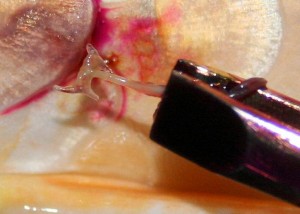Anchor worms (Lernea or also Lernaea Elegans for those that like official names) is a common parasitic infection for koi. They are not actually worms, but rather crustaceans that burrow deep under the scales and into the muscles of freshwater fish—usually near the base of fins.
Although they can destroy muscle fibers, the main danger of Anchor Worms is not the parasite itself, rather the threat of secondary infections to which your weakened koi is now susceptible.
Unlike other illnesses already in the water that opportunistically attack your koi, Anchor Worms are brought in by other infected fish or on plants added to the pond that have larvae attached.
Using anchors on the side of the head, it is the females that attach to your koi. The eggs they produce are then fertilized by the male for the next generation of anchor worm larva to be released into the water column.
Symptoms
Although they can be seen with the naked eye, appearing as greenish white threads or pieces of floss, there are other symptoms that tell you your koi have crustacean parasites. They are:
- flashing
- red, inflamed spots (where the parasite is embedded)
- ulcerations on the skin
- difficulty breathing
- lethargy
- loss of appetite
Treatments
Standard protocols for parasites are often most effective. They include:
- Potassium permanganate—either as a dip in a quarantine tank or entire pond (5-10ppm)
- Dimilin
- Formalin (exercise caution if it has open wounds, though)
- salt dip (to lessen secondary infection)
WARNING: properly measure the volume of your pond and administer the appropriate dosage of chemical treatments. Overdosing can be fatal.

As they are visible, anchor worms can be removed with tweezers; but if you attempt it, here are some things to remember:
- grab them as close to the entry point as possible
- make sure that the entire parasite is pulled
- disinfect the wound afterwards (to minimize infection)
- only keep the koi out of the water for a few seconds at a stretch (and especially if it is already stressed)
- removal may cause more stress and trauma than leaving it in, so treating them chemically can be a better alternative
When treating a koi with anchor worms remember that the cure isn’t instantaneous. Depending on the water temperature, this crustacean can take a week or more to eradicate. And because of the lifecycle of the anchor worm, there is the possibility of fish that don’t appear to be infected can eventually have them show up.
Next Day Koi exercises strict quarantine protocols with all of our new koi fish for sale to ensure that they are infection- and illness-free. They are placed in separate holding tanks for 14 days and are closely monitored for any signs of infection.
Contact us to see how we can help you get your next living jewel into your pond or tank.


[…] Anchor Worms and Your Koi […]